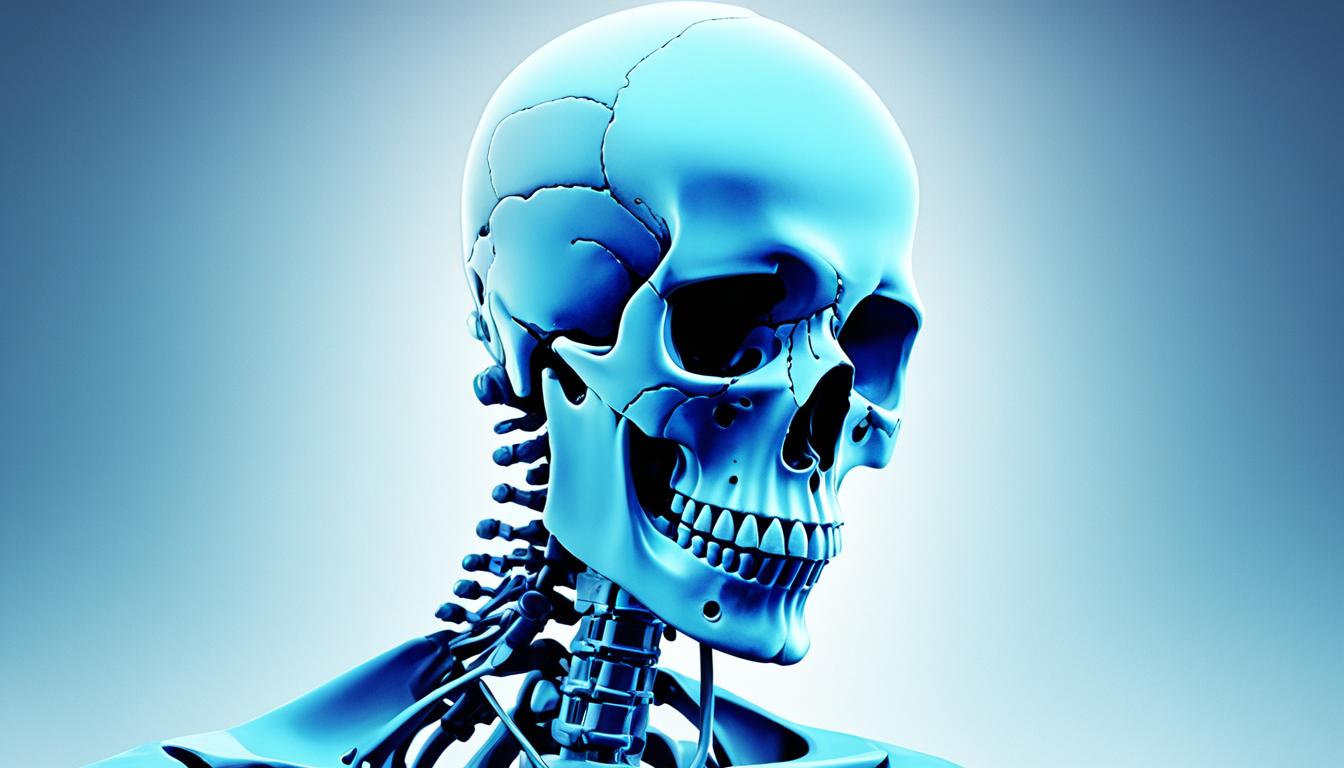Chordoma is a rare cancer affecting mainly the skull and spine bones. It starts in the notochord, supporting embryo development. Often found in older adults, it can appear at any age. Symptoms vary by location, including back pain and issues with movement or control.
The exact cause of chordoma remains unknown. Research suggests genetic issues, like brachyury gene mutations, may be a factor. Some cases are sporadic, but it can run in families too.
Surgery, radiation therapy, and proton therapy are common treatments. Surgeons try to remove most of the tumor while keeping nerves safe. Yet, they can’t always remove it all. Radiation helps lower the chances of it coming back. Proton therapy, using protons instead of X-rays, is becoming more common. Stem cell therapy is also under study for treating chordoma.
The Chordoma Foundation offers important help and information for those impacted by chordoma.
Key Takeaways:
- Chordoma is a rare cancer that primarily affects the bones of the skull and the spine.
- Genetic abnormalities, such as mutations in the brachyury gene, may be involved in the development of chordoma.
- Surgery, radiation therapy, and proton therapy are common treatment options for chordoma.
- Stem cell therapy is being researched as a potential treatment option for chordoma.
- The Chordoma Foundation supports individuals and families affected by chordoma through resources and research advancements.
Symptoms of Chordoma
Symptoms of chordoma change based on the tumor’s size and place. They can happen anywhere on the spine. This includes the base of the skull, spinal cord, and sacrum. Typical signs of chordoma are:
- Back pain
- Weakness
- Numbness in the back or legs
- Bladder and bowel abnormalities
- Headaches
- Double vision
- Facial pain
- Swallowing difficulties
- Neck pain
- Hoarseness
- Difficulty swallowing
Chordoma may even lead to hydrocephalus. This happens when too much cerebrospinal fluid builds up in the skull. It then presses on the brain.
Causes and Risk Factors of Chordoma
The exact causes of chordoma remain a mystery. However, experts think that mutations in the brachyury gene play a significant part. This gene usually helps during the early stages of life. Yet, when it mutates, chordomas might form. Most of the time, these mutations are not passed down and happen randomly.
In some families, though, chordoma might run in the genes. Seeing several family members with chordoma hints at a possible genetic connection. Scientists are hard at work trying to understand these genetic links better.
As for what raises the risk of getting chordoma, we currently don’t know any outside causes. It’s not tied to what you eat, how you live, or what you’re exposed to. This mystery makes it tough to prevent. Still, there’s a continuous effort to uncover more about the potential risks and how to stop them.
Risk Factors for Chordoma
| Factors | Explanation |
|---|---|
| Genetic Abnormalities | Mutations in the brachyury gene may contribute to chordoma development, but most cases occur sporadically. |
| Heredity | In rare cases, chordoma can be hereditary, with multiple family members being affected. |
| Environmental Factors | No known environmental factors have been identified as significant risk factors for chordoma. |
| Dietary Factors | No specific dietary factors have been linked to an increased risk of chordoma. |
| Lifestyle Factors | No specific lifestyle factors have been associated with chordoma risk. |
We’re still learning about the causes and risks of chordoma. Research is unveiling more about genetic issues and family ties with this disease. This knowledge is crucial for improving how we detect, treat, and maybe even prevent chordoma in the future.
Treatment Options for Chordoma
Treating chordoma involves a team of specialists. They include oncologists, radiation oncologists, neurosurgeons, and orthopedic surgeons. The top treatment is surgery. The goal is to take out as much of the tumor as possible. But, sometimes they can’t remove it all.
Radiation therapy is also used to treat chordoma. It’s combined with surgery to decrease the chances of the cancer coming back. This treatment zaps cancer cells with high-energy X-rays or protons. Proton therapy for chordoma uses protons for more accurate treatment. It aims to harm the cancer, not the healthy tissue around it.
Stem cell therapy is another area of research for chordoma. Stem cells can turn into different cell types. Scientists are seeing if they can help repair damage and improve patient outcomes. But, more studies are needed to know how well this works.
The Chordoma Foundation supports people with chordoma and their families. They offer helpful resources and information. Their goal is to make life better for chordoma patients. They also work to find new and improved treatment options for chordoma.

